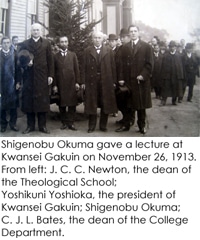- TOP
- About Kwansei Gakuin
- History and Educational Philosophy
- L' Esprit de Kwansei Gakuin(2)

L' Esprit de Kwansei Gakuin
L' Esprit de Kwansei Gakuin
> April 2009 -October 2011 > December 2011 -February 2016 > April 2016 -
A Prediction That Came True
At a little past 9:00 am on February 28, 1917, the Middle School students were on their way to chapel service after finishing their first class. The music teacher, Masa Okajima, who was the former president’s sister-in-law, heard crackling from a store room on the third floor, opened the door, found a mass of flames, and rushed to raise the alarm. Teachers and students united to save important documents and school items from the fire, with some quite heroic efforts. One student managed to carry a big organ out of the building all alone, and another blocked the passage connecting the main building and its annex to prevent the spread of fire.
The Middle School building, completed just four years before, was burned out within a short time. There were no water facilities at Harada-no-mori in those days, and 135 hoses had to be connected from the water supply at Kamitsutui Station, the street car terminus.
Harada-no-mori might have become the new campus of the Daisan Higher School, which in 1949 became part of Kyoto University (founded as Kyoto Imperial University in 1897). The origin of the higher school dates back to two schools founded in Osaka in 1869: Seimi-kyoku (a state school of chemistry) and Yo-gakko (a state school of Western studies). The two were combined into Daisan Higher Middle School in 1886, renamed Daisan Higher School in 1894, and moved from Osaka to Kyoto in August 1889. This restructuring began to take shape in 1885 with the plan to establish an associated university. After the strongest candidate for a school and university site, Fushimi in Kyoto, was given up, the school authorities strongly recommended Harada-no-mori in Hyogo, where Kwansei Gakuin would be founded in September 1889.
According to issue number 7, 1927, of the Alumni Bulletin of Kwansei Gakuin Commercial College, when the plan to establish Daisan Higher School at Harada-no-mori was being developed, an architect noted that all the school buildings would be very vulnerable if there were a fire. So the planners tried to find a better place and the school was instead established at the foot of Mt. Yoshida, Kyoto.
Yuko Ikeda, Kwansei Gakuin Archives(February 2016)
[Special thanks to Camilla Blakeley for editorial assistance in English.]
【 Click to enlarge. 】

The T. H. Haden Diaries
T. H. Haden came to Japan in August 1895 at the age of 32 as a missionary from the Methodist Episcopal Church, South. At Kwansei Gakuin he served as the second dean of the Biblical Department, succeeding J. C. C. Newton. Haden worked in Japan for 45 years until 1940.
One year after arriving in Japan, he began to keep diaries, which are now in the possession of Emory University in Atlanta. He wrote the first entry on October 21, 1896, describing the details of his first trip to Japan, taken the previous year. He had left his father’s house in Palmyla, Virginia, on the morning of July 22, 1895, and went to Nashville, Tennessee, to get married to Jennie Conwell on the 27th. The newly married couple joined Newton in Chicago. From there they travelled across the continent to Vancouver on the Canadian Pacific Railway and then made the ocean voyage to Kobe via Yokohama, travelling on the Empress of India. Newton had gone to Japan for the first time in 1888 and was then on his way back after spending his first furlough in the United States.
The diaries teach us many things. For example, Haden tells us that C. J. L. Bates, who later became the fourth president, arrived at Kwansei Gakuin on September 6, 1910. He was the first representative of the Canadian Methodist Church. The Bates family stayed at Haden’s home until the morning of September 10, waiting for the arrival of their furniture and preparing for their own house.
On September 15, 1918, Haden notes that Ian Ozolin is temporary occupying his guest room. The young Latvian had been employed to teach English for a year beginning that month and could not find a suitable place to stay. The diary also tells us that Ozolin did not take meals at Haden’s house but at a student dormitory. Haden’s wife had died the previous year, leaving a bachelor household, and Ozolin may have preferred to eat Japanese food among the students. It is also interesting to see that Haden initially referred to Ozolin as “Siberian” but then corrected himself to “Latvian.”
Yuko Ikeda, Kwansei Gakuin Archives(February 2015)
[Special thanks to Camilla Blakeley for editorial assistance in English.]
【 Click to enlarge. 】
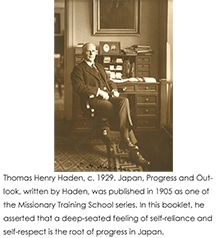
Shoin’s Short Sword
Ralph E. Outerbridge was born and raised in Japan, the son of H. W. Outerbridge, a missionary teaching at Kwansei Gakuin. On leaving Japan for Canada in 1929 to study medicine, he was invited by one of his father’s former students to see his sword collection at home. Ralph collected Japanese swords himself as a hobby, and the man presented him with a beautiful short sword (wakizashi) as a memento.
In 1979, some fifty years later, Ralph Outerbridge was living in Vancouver as a surgeon. On a whim one day, he took the sword down from its support on his study wall. The brocade sheath was showing its age, and its black cotton inner lining had almost completely rotted away. At the base of the silk sheath, some of the brocade thread had split and closer examination revealed something white lying within the casing. Easing this out carefully, he found it to be a piece of white silk on which was written in Japanese, “This type of sword was favoured by Yoshida Shoin. This sword was worn by Yoshida Shoin. It is a memorial sword. The accessories are made of gold and silver. This is a Fujita family treasure.”
This discovery was astonishing. Yoshida Shoin, born in 1830 in a small city of Hagi, was the instigator of the Meiji Rebellion, responsible for the downfall of the Tokugawa Shogunate. When Shoin defied the government ban on foreign travel and stowed away on one of Admiral Perry’s “Black Ships” in 1854, his sword was left in a small boat, which was found on the sandy shores the next morning. Shoin was apprehended and jailed, but his sword was returned to him.
Later, Hyogo Prefectural Governor Ito Hirobumi who had studied under Shoin and eventually became the first prime minister of Japan, gave the sword to Fujita Taizo. There is no evidence other than the piece of white silk to confirm the provenance of the sword, however, so we can only say that it is thought to have belonged to Yoshida Shoin.
If the message was true, Ralph thought, the sword should be returned to its proper place. On June 8, 1988, at the site of Shoin’s birth, he returned the sword to Koike Harumitsu, the Mayor of Hagi, making a speech in Japanese: “I have lived and worked in many different countries around the world. During this time I was completely unaware of the secret message hidden within the original silk case in which the sword lay. The message indicates that the sword originally belonged to Yoshida Shoin, your great national hero. I have come to believe that I have unknowingly, and undeservingly, played a part in the destiny of this sword and its owner. In travelling the world the soul of this sword has been on five continents and has thereby completed successfully Shoin’s unfulfilled dream.” Some 129 years had passed since Shoin was beheaded.
Yuko Ikeda, Kwansei Gakuin Archives(July 2015)
[Special thanks to Camilla Blakeley for editorial assistance in English.]
【 Click to enlarge. 】
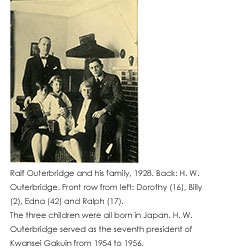
The Miserable Trio
It was not easy to elect the fourth president of Kwansei Gakuin. When J. C. C. Newton insisted on resignation because of his age, three candidates to succeed him were nominated at a meeting of the directors of the Board of Trustees in February 1920: R. C. Armstrong, C. J. L. Bates, and Masukichi Matsumoto. After active discussions and several votes, no clear winner emerged. It was decided to postpone the election until the regular spring meeting.
Two month later, Bates, Matsumoto, and D. R. McKenzie were nominated. The ballot was taken and Bates, who was Newton’s choice from the beginning, was finally elected as the fourth president. At 42, he was young enough to be the 71-year-old Newton’s son.
Bates learned of the election result by cable on April 29, 1920. At the time, he was in Ottawa, Canada, because of his younger brother’s sudden death. He had already resigned from Kwansei Gakuin and was working for the Central Tabernacle (present-day Hongo Central Church) in Tokyo, and had received an official offer from the Yale Divinity School as well. He wanted to accept the presidency immediately but he did not have sufficient money to get back to Japan.
“I am $750 in debt in Japan. The recent grant made by the executive will reduce that to $450, but I have to arrange for my travelling expenses. They will amount to over $800. Could the Mission Board not assist me in this matter? … I know I have no claim, and shrink from making the request,” he wrote to Dr. James Endicott, general secretary of the Board of Foreign Missions of the Methodist Church of Canada, on April 30, 1920. Bates seems to have been successful in obtaining some money, however, as his inaugural ceremony was held on October 15 at Kwansei Gakuin.
Yuko Ikeda, Kwansei Gakuin Archives(April 2015)
[Special thanks to Camilla Blakeley for editorial assistance in English.]
【 Click to enlarge. 】

The Best English Speaker and the Treasure of the Literary College
In the early years of Kwansei Gakuin, many of the Japanese teachers had very good English. Most of them had studied English from the missionaries, and some had also studied in the United States. Among them, Yoshikuni Yoshioka, the second president, was said to speak the best English in Japan. There are several well?known stories about his excellent English ability.
Charles Fairbanks, the US vice?president under President Theodore Roosevelt (1901?09), came to Kobe in 1909 and gave a lecture at Kobe Commercial College. Afterwards, the college principal, Tetsuya Mizushima and Yoshioka expressed their gratitude. Fairbanks deeply admired the refined English spoken by Yoshioka, remarking, “I didn’t expect to hear such sophisticated English in Japan.” Another time, Yoshioka went to a coffee shop near the Harada?no?mori campus with some students. Because he asked for the Japanese soft drink “orange cider” using perfect American pronunciation, his order was not understood. Later, after the Second World War, Yoshioka again illustrated his English ability, posting a wooden sign on his gate for the benefit of the occupation forces. It read, “Please come in if you need any assistance.”
In contrast to Yoshioka, Hirosuke Murakami, who taught Chinese classics at the Academic Department, Biblical Department, and Literary College, never spoke English. Yet he read English literature without difficulty, kept a diary in German, and even knew French. According to the Bungakubu Kaiko (Memoirs of the Literary College), 1931, Murakami was a man of great dignity and character and was admired as a “treasure” of the college. Although he had been baptized by W. R. Lambuth in Hiroshima, he spoke only Japanese with American missionaries. His confidence in Japanese culture was appreciated by the students in a different way from Yoshioka’s talents.
Yuko Ikeda, Kwansei Gakuin Archives (February 2015)
[Special thanks to Camilla Blakeley for editorial assistance.]
【 Click to enlarge. 】

Adjustment to the Home Country
Missionary children living in China or Japan were usually schooled by their parents. However, formal schooling was also very important and at a certain age they would often be sent back alone to attend school in their home country. Such young people often found the adjustment hard.
Nora Lambuth, sister of Walter, who later founded Kwansei Gakuin, moved from China to Nashville, Tennessee, in 1874 at the age of eleven to attend school. She and Walter lived with the family of Dr. D. C. Kelly. Although she was with her dearest brother, he was older by nine years and it was too lonely for such a little girl to be left without parents in a strange country and among strange people, no matter how kind. Many a night she cried herself to sleep yearning for her father and mother, her Shanghai home, and her Chinese friends. She was also given the duty of darning her brother’s socks, which she found difficult and tedious.
Paul Demaree, whose father was the American missionary in Matsuyama, Japan, was sent to a high school in McKenzie, Tennessee, in 1910. Paul’s father had a Chinese tailor in Kobe make a good suit for him to wear back to the home country. It was well made and of good material but out of style. At his new school, a group gathered around him and started the inquisition:
“Them duds you’re awearing, they’s Japanese clothes, ain’t they?”
“No. They were made by a Chinese tailor in Kobe. They are American style clothes”
“Are you a Japanese or a Chinese?”
“Neither one. I’m an American. Do I look like a Japanese?”
“Yes, you do. We’ll call you ‘Jap’.”
“That’s it. His name is JAP! Jap Demaree.”
Paul did not resent the nickname. In fact he was glad to have it. To him it was the first indication of his acceptance by the group. So the nickname stuck with him all the way through school and college.
Yuko Ikeda, Kwansei Gakuin Archives (December 2014)
[Special thanks to Camilla Blakeley for editorial assistance.]
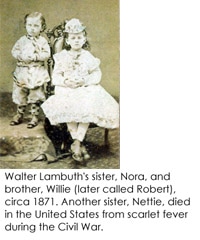
Center of Life, Light, and Power
From the president’s office of the Harada-no-mori campus, hundreds of boys and young men could be seen making their way along the winding road from the main entrance to the center of campus every morning. Mingling among them were foreign boys and girls on their way to the Canadian Academy, which was located immediately north of Kwansei Gakuin. President C. J. L. Bates looked down from his office window at them in 1922 and thought, “Truly this Kwansei Gakuin is a cosmopolitan place, an international center. It is a privilege to live [here], a privilege to teach here, a privilege to study here if our eyes, hearts, and minds are open.”
An old Shinto shrine stood in the middle of campus, and around this center of worship school buildings had been constructed of brick, one after another: Divinity Hall in 1912, Middle School in 1913 and 1919, the Central Auditorium and the Literary College in 1922, and the Commercial College in 1923. Bates was impressed by the contrast between old and new. As he wanted to preserve the best of the old ways, he honored the achievements of those who had gone before while admiring the spirit of progress.
From his office window, he could catch glimpses of the distant city, the steel works, and the harbor, which linked Japan to the world over the sea. When Kwansei Gakuin was founded in 1889, there was very little infrastructure and people were often afraid of thieves around the sparse campus after dark. The landscape had changed dramatically in 30 years as the transportation network developed and now ? with the opening of Kamitsutsui streetcar station in 1919 and Hankyu Kobe station in 1920 ? people could get from the school to downtown Kobe by streetcar and to Osaka by train. The radish fields had gone and many shops and restaurants lined the street in front of the main entrance to the campus.
Embracing “the old and the new, the practical and the ideal, the bad and the good, the dying and the living, and Kwansei Gakuin in the center of it all,” Bates appealed to the students, “Let us make Kwansei Gakuin a center of life, light, and power. We can do it if we will.” That was 92 years ago, in the second year of his presidency, but Kwansei Gakuin still retains these early ideals.
Yuko Ikeda, Kwansei Gakuin Archives (September 2014)
[Special thanks to Camilla Blakeley for editorial assistance.]

The Ashes, Missing or Hidden
W. R. Lambuth founded Kwansei Gakuin in 1889. Although he left Japan less than two years later, he continued to pay attention to the school. He visited the country several times and made a speech at the KG graduation ceremony in 1907.
Lambuth died in Yokohama on September 26, 1921. His ashes were carried from Yokohama to Kwansei Gakuin and the urn was displayed in the auditorium of the Divinity Hall. On October 3, a memorial service was held in the Kwansei Gakuin Chapel. A few days later, a delegation from the school carried the urn to Onohama Cemetery for a ceremonial farewell to Lambuth’s father, who had died in Kobe in 1892. According to Yoshikuni Yoshioka, the second president of Kwansei Gakuin, the school had to honour Mrs. Lambuth’s wish to bury the ashes in Shanghai despite strongly wanting to keep them in Kobe. Instead, some of the founder’s hair was placed within the foundation of the Central Auditorium.
On October 11, the funeral service was held at a church in Shanghai (the present-day Moen Church) and the ashes were buried next to M. I. Lambuth, his mother, in plot 27 of section E of Pah Sien Jao Cemetery. In December 1957, the remains were moved to Ji-An Cemetery, where the mother was buried in plot 101 and the son in plot 102 in section 6. Sadly, that cemetery was destroyed during the Cultural Revolution, probably in May or June 1967, and the ashes went missing, according to research by Dr. and Mrs. W. D. Bray in 1980. In later years, Chancellor Ichiro Yamauchi and Professor Kenji Kanda each visited Shanghai to follow up on that research.
Despite this regrettable story, there is a heartwarming one about the Christian Cemetery in Soochow. During the Cultural Revolution, the cemetery was destroyed but someone rescued the bronze urn containing the ashes of W. H. Park, Lambuth’s brother-in-law, and hid it for years. In 1987 it was reburied at the new Christian Cemetery. Park had devoted his whole life to a medical mission in China. He used to say about his friendship with Lambuth, “So you see I got Dr. Lambuth’s house, his furniture, his hospital, his medical school, and his Sister…”
Yuko Ikeda, Kwansei Gakuin Archives (July 2014)
[Special thanks to Camilla Blakeley for editorial assistance.]
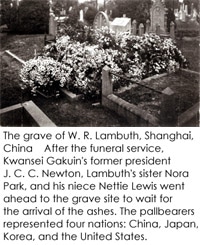
A Little School Feels Newton’s Warmth
“He is a man for whom we may well thank God when leadership counts for so much in the Orient.” So said W. R. Lambuth, the founder of Kwansei Gakuin, about J. C. C. Newton, the first dean of the Biblical Department and the third president of the school. The little newborn school was beset by difficulties, one after the other, and in Lambuth’s opinion, Newton had solved them all and forged the school identity.
One day a stranger in distress came to Harada-no-mori. Illness had forced him to withdraw from the Agricultural College of Tohoku Imperial University (present-day Hokkaido University). As he came to the main entrance, a white-haired old man met him and cordially listened to his story. The stranger’s name was Kokichi Hiraga, and he decided to enter the Literary College following this kind man’s advice. Later, Hiraga became a teacher at the Middle School. The old man was Newton, the dean of the Biblical Department at that time.
Another time, Newton attended a divinity students’ meeting at their dormitory, Seizen-ryo. The meeting ran late and Newton stayed to eat dinner with them. The dish of simmered okara (tofu lees) and inago (locusts) with soy sauce and sugar was new to him. Several days later, three roast chickens were delivered to the dormitory from Newton’s house. More than forty students enjoyed the tasty food and deeply appreciated his kindness.
H. W. Outerbridge, the seventh president, wrote about Newton, “He was a most human[e] and kindly person, a sort of grandfather to us all, teachers and students alike, and took a most fatherly interest in everyone on the campus. Especially during the later years, after he became President, he carried about with him an aura of dignity and almost of sanctity, which no one could ever forget.” Though Newton was often forced to make difficult decisions about school management, the little school at Harada?no?mori always felt his warmth.
Yuko Ikeda, Kwansei Gakuin Archives (June 2014)
[Special thanks to Camilla Blakeley for editorial assistance.]
【 Click to enlarge. 】
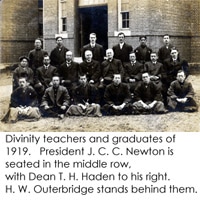
Rev. W. B. Palmore and Kwansei Gakuin
On November 26, 1886, W. R. Lambuth, later the founder of Kwansei Gakuin, opened a reading room for young men in Kobe. The Reverend William Beverly Palmore of Springfield, Missouri, who had been in the first class registered at Vanderbilt University, Lambuth’s alma mater, visited Kobe. He took a deep interest in Lambuth’s new library, which was open every night, and established an annual donation of $100. He also promised to send books and periodicals. On January 4, 1887, the Japan Mission of the Methodist Episcopal Church, South, therefore resolved that the reading room would be known as the Palmore Institute. A lecture or debate was held there every Saturday night.
On November 1, 1888, N. W. Utley began offering a day class at Palmore Institute and in January 1889 he opened a regular day school, where he offered in both English language and the principles of Christianity. When Kwansei Gakuin was founded on September 28th in the same year, Utley became the first dean of its Academic Department. William Palmore therefore had a significant connection to the earliest history of Kwansei Gakuin.
Palmore began his preaching career in Kansas City in 1877. In 1890 he moved to St. Louis and became the editor of the St. Louis Christian Advocate, a post he held for twenty-some years. He was known not only as a Methodist preacher but also as a worldwide traveler. In Mexico, he assisted in the establishment of the Colegio Palmore. As he was preparing to return home from one of his world tours, the cab in which he was riding in Paris was involved in a collision and he suffered a broken shoulder. His hospitalization forced him to give up his ticket on the maiden voyage of the Titanic.
In the very early days of Kwansei Gakuin, some of the Japanese teachers had studied in Missouri. One such instructor was Genta (George) Sudzuki, who came to Kobe from Shanghai in 1886 with the Lambuths as their translator. He became the first Japanese member of their Japan mission and studied at Central College (now Central Methodist University) in Fayette from 1887 to 1894. When I visited there last October, university archivist John Finley told me that the Rev. Palmore had supported several students financially. Palmore was awarded an honorary doctor of divinity degree in 1900. It seems that Kwansei Gakuin owes Palmore more than one debt of gratitude.
Yuko Ikeda, Kwansei Gakuin Archives (April 2014)
[Special thanks to Ann Kennedy for the information on W. B. Palmore.]
[Special thanks to Camilla Blakeley for editorial assistance.]
【 Click to enlarge. 】
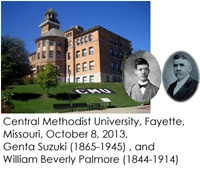
The Boxer Rebellion for Bates and Park
C. J. L. Bates was the fourth president of Kwansei Gakuin, serving from 1920 to 1940. In 1902, however, at the age of 24, he was a student at the Wesleyan Theological College and served at the Dorchester Street Methodist Church in Montreal.
In January of that year, Dr. F. C. Stephenson visited the college and asked Bates if he was going to the Student Volunteer Convention in Toronto the next month. Bates had neither the time nor the money. Dr. Stephenson encouraged Bates to attend, pulling ten dollars from his pocket to help the young man.
At Massey Hall in Toronto, Dr. John R. Mott read a telegram from China: “North China calls. Fill up the gaps.” The reference was to consequences of the earlier Boxer rebellion, in which 250 missionaries and thousands of Chinese Christians had been killed. Some 300 young men and women responded, and Bates was one of them. He decided to devote his life to missionary work in Asia. A few weeks later, Bates was appointed to go to China, though his appointment was soon changed to Japan.
There is, however, another link between Kwansei Gakuin and the Boxer rebellion. The rebellion had occurred in 1900. At that time Nora Park, a sister of Walter R. Lambuth, the founder of Kwansei Gakuin, lived with her family in Soochow in the Yangtze River valley. When all missionaries were ordered to leave their stations and go to Shanghai, Li Hongzhang undertook to keep the situation calm in the area. As a proof of faith in him, Nora’s husband, W. H. Park, a medical missionary, was asked to stay on in Soochow, as a sort of hostage. Nora decided to remain with their daughter in order to support her husband. There was much to do. The hospital where Park worked was full of patients, and every day Chinese officials came to see that they were safe.
One day Park was out travelling in his sedan chair to visit the sick. The men carrying his chair put it down to find the number of the house, and as they did so, a crowd gathered and the cry was raised, “Kill the foreigner!” Just then, someone raised the flap of covering the windowed cabin of the chair and looked inside. “That’s not a foreigner,” he declared. “That’s just Dr. Park.”
Yuko Ikeda, Kwansei Gakuin Archives (February 2014)
[Special thanks to Camilla Blakeley for editorial assistance.]
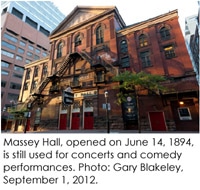
The Tokyo Olympics, 1964
The 2020 Summer Olympics will be held in Tokyo again. The last time was in 1964, when the XVIII Olympiad was held there from October 10th to 24th, as the first Olympic games in Asia. Ten Kwansei Gakuin graduates and one student took part in six sports: diving, track and field, riding, football, volleyball, and wrestling.
The Japanese women’s volleyball team won the gold medal. The head coach was Hirofumi Daimatsu, who had belonged to the KG volleyball team as a student. “Daimatsu was a star player, good at a touch attack with the left hand and spiking with the right,” said Kazuaki Sueo, one of his former teammates.
A week before the Olympics, the Kwansei Gakuin University Symphony Band left Japan for a concert tour of Canada. It had won a national contest for the past two years. The tour was designed as a kind of return salute for Prime Minister John Diefenbaker’s visit to Kwansei Gakuin in 1961.
The band took the return flight of the charter that had carried the Canadian team to Japan. In fact, many tour planners had attempted to make use of the return flights of arriving athletes, but all were rejected because it was feared that the scheme would have a bad effect on the airfare system. According to the Old Kwansei, no. 32, only the Kwansei Gakuin application was granted, by special permission of the Ministries of Foreign Affairs and Transport.
The KG group flew directly from Tokyo to Montreal in twelve and a half hours, the longest flight of a commercial aircraft at that time. The concert tour started at McGill University, the alma mater of C. J. L. Bates, the fourth president of Kwansei Gakuin. Eight members of the group visited the grave of President Bates, who had passed away the previous year. H. W. Outerbridge, the seventh president of Kwansei Gakuin, who had retired to Hamilton, Ontario, accompanied the KG players for three days.
From Montreal, the group crossed the country by bus to the University of British Columbia, in Vancouver. The group played more than twenty concerts, winning applause from local audiences and media. The KG Symphony Band arrived back safely in Tokyo late on the day the Olympic closing ceremony was held.
Yuko Ikeda, Kwansei Gakuin Archives (December 2013)
[Special thanks to Camilla Blakeley for editorial assistance.]
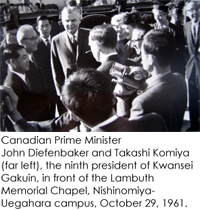
The Kwansei Gakuin Golden Jubilee
On October 14, 1939, Kwansei Gakuin held the fiftieth anniversary ceremony of its founding. On June 30 C. J. L. Bates, the fourth president, sent out an invitation to numerous universities abroad. We do not know to which institutions it was sent, but the Archives contain nearly seventy replies, not only from Canada and the United States but also from England, Scotland, Ireland, Lebanon, Africa, India, Australia, and New Zealand. Twenty schools wrote to confirm that they would attend the ceremony. Some of responses were from universities currently affiliated with Kwansei Gakuin, such as Southern Methodist University, Victoria University, and Mount Allison University.
In those days it was not easy to send a delegation by ship far away to Japan for an occasion such as this. A number of institutions tried to contact their graduates living in Japan to ask them to represent their alma mater. Zensuke Hinohara was delegated by Duke University, S. M. Hilburn by Southern Methodist University, W. K. Matthews by Vanderbilt University, and his wife, Eva, by Randolph-Macon Woman’s College.
By this time Bates had already noticed that several people around him believed a Japanese person should fill the post of president of Kwansei Gakuin, and he had begun to think of resigning. Under such difficult circumstances, he wanted institutions all over the world to celebrate the jubilee of Kwansei Gakuin together.
Kenneth Sills, the president of Bowdoin College, Maine, received an invitation with a brief note about the mission and history of Kwansei Gakuin. He wrote back to Bates, “In these days of tension and uncertainty institutions of higher learning can do much to bring about international friendliness and good-will.”
Yuko Ikeda, Kwansei Gakuin Archives (October 2013)
[Special thanks to Camilla Blakeley for editorial assistance.]
【 Click to enlarge. 】

An Amazing Task: W. M. Vories and the Humanity Declaration
The friendship between C. J. L. Bates, the fourth president of Kwansei Gakuin, and William Merrell Vories, the Kansas-born architect of its Nishinomiya-Uegahara campus, is well known. The first work by Vories for Kwansei Gakuin was a plan for Divinity Hall (completed in 1912) at Harada-no-mori, the old campus site. At the end of December 1940, Bates left Japan to return to Canada with his wife, who was by then partially paralyzed. Vories remained because he had married a Japanese woman and become a naturalized Japanese citizen, taking the family name Hitotsuyanagi.
In an interesting article entitled “The American Who Saved the Emperor” (Chuo Koron, May 1986), Fuyuko Kamisaka discusses an attempt by Vories to mediate between Douglas MacArthur, Supreme Commander for the Allied Powers, and Prince Fumimaro Konoe of Japan after the Second World War.
Let me note Vories’ own words in a letter of March 24, 1947, written to Bates in Canada: “I was the Prince’s private messenger to arrange his first meeting with General MacArthur, and it was my amazing task, eventually, to suggest the Emperor’s declaration that neither he nor his Ancestors considered themselves ‘gods.’ I was even asked by the Prince to make an English draft of the sort of statement which would be comprehended by foreigners ? as both he and I understood the Emperor’s real sentiments.” Vories recorded in his diary that he fulfilled the Prince’s request, coming up with the idea for an imperial rescript, or declaration, in the early morning of September 12, 1945.
Emperor Showa (Hirohito) issued the Humanity Declaration on January 1, 1946. Until Vories wrote to Bates, his “amazing task” was unknown, and the letter shows the trusting relationship between the two men. When I visited Armand de Mestral, Bates’s grandson, in Montreal in 1999, I found the letter among articles that had been left by Bates.
Yuko Ikeda, Kwansei Gakuin Archives (August 2013)
[Special thanks to Camilla Blakeley for editorial assistance.]
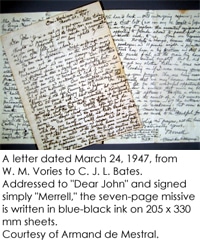
The Meaning of the Crescent Moon
J. C. C. Newton, the third president of Kwansei Gakuin, was born and grew up in Pendleton, South Carolina. When his great-grandson, Emory Underwood, took me there from North Carolina in 2002, I was surprised to learn that the state flag of South Carolina is a white crescent moon on a blue field. The crescent moon is also the school symbol of Kwansei Gakuin. What did this coincidence mean?
In 1894, five years after the foundation of Kwansei Gakuin, the crescent moon was selected as the school symbol. It is said to have two meanings: we shine as we receive the favor and love of God, just as the moon is lit up by the sun; and we improve and progress toward an exalted ideal, just as the new moon gradually waxes. In later years, Yoshikuni Yoshioka, the second president, was asked by a graduate to explain the true motive behind the choice of the crescent moon, but Yoshioka answered, “We didn’t have any special reason. In the old days there was a samurai who put a crescent mark on the front of his kabuto [helmet]. We borrowed this idea.”
When we look for connection between this story and the life of Newton, the American Civil War comes to mind. At seventeen, Newton joined the Confederate army and fought for his home state. The crescent moon had been the state symbol of South Carolina since colonial days and he would have worn it on his soldier’s cap. In fact, the crescent was apparently put on the soldiers’ caps for the first time in February 1760, and during the American Revolution some unites fought with “PRO PATRIA” or “LIBERTY” emblazoned within the crescent.
Taruho Inagaki, who studied at Kwansei Gakuin during the era of President Newton, was strongly taken with the symbol of the crescent moon. When a teacher told him that the budge on his cap was crooked, he puffed out his chest and replied, “I have changed its angle to reflect the inclination of the real moon in the sky.”
Yuko Ikeda, Kwansei Gakuin Archives (June 2013)
[Special thanks to Camilla Blakeley for editorial assistance.]
【 Click to enlarge. 】
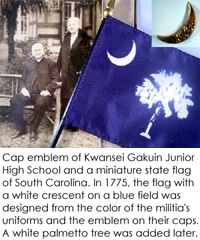
Yoshikuni Yosioka and the Vanderbilt University Connection
Yoshikuni Yoshioka, a professor of the Biblical School, Kwansei Gakuin, was sent to study in the Theological Department of Vanderbilt University, Tennessee, in 1890. It was the alma mater of W. R. Lambuth, the founder of Kwansei Gakuin. Yoshioka spent two years of fruitful study at Vanderbilt, and returned to Kwansei Gakuin to become its second president, in 1892.
While he was in Tennessee, Yoshioka became good friends with a Korean student named Yun Chi-ho. Yun had studied at the Anglo-Chinese College, Shanghai, and had come to Vanderbilt through the kind support of W. B. Bonnel and Y. J. Allen, missionaries from the Methodist Episcopal Church, South. Yoshioka and Yun seem to have already known each other in Japan through Lambuth. They often exchanged opinions about religious life, world affairs, and their view of marriage, and occasionally had heated discussions. Yun wrote in English in his diary, “He [Yoshioka] is a very nice fellow and speaks English very well.”
Yoshioka told Yun that he was destined to be a politician, not a preacher, and he was right. Yun went back to Korea, and threw himself into the independence movement. After Japan was defeated in war, Yun was blamed for his pro-Japanese attitudes and it is said that he committed suicide.
S. E. Hager was also studying at the same university at the same time but one year behind Yoshioka. After graduation, he became a missionary to Japan and served as the dean of the Academic School at Kwansei Gakuin and also as acting president while President Yoshioka was undergoing medical treatment.
Tokichi Masao, a student at the Biblical School, Kwansei Gakuin, came to Vanderbilt one year after Yoshioka. He completed the divinity course there, went to West Virginia to change his major from theology to law, and later became a legal advisor to the Siamese government. He died in Bangkok while working as a minister from Japan.
A few years before Yoshioka and Yun, Charles Jones Soong had studied at Vanderbilt, too. After his studies, he returned to his native China, entered the business world by printing bibles in Shanghai, and made a fortune. Soong was the father of three very well known sisters whose lives are depicted in the movie titled The Soong Sisters. The girls were sent to the United States to study. The eldest daughter, Ai-ling, married H. H. Kung, a wealthy banker who was believed to be the descendant of Confucius; the second daughter, Ching-ling, married Sun Yat-sen; and the third daughter, May-ling, married Chiang Kai-shek.
Vanderbilt University produced some illustrious alumni, and Yoshikuni Yoshioka was in good company. His time there was an excellent grounding for his later work as school president.
Yuko Ikeda, Kwansei Gakuin Archives (April 2013)
[Special thanks to Camilla Blakeley for editorial assistance.]
【 Click to enlarge. 】
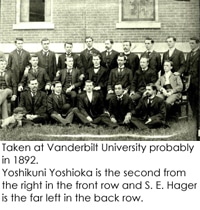
Memories of an Alma Mater
Graduates have a special feeling, a kind of nostalgia, for their alma mater. When they visit the campus after a long absence and cannot find a familiar sight, how do they feel? Many Kwansei Gakuin graduates miss the Senior High School building, formerly the Middle School, and the Chapel of the School of Business Administration, formerly the Higher Commercial School. Now, the Central Auditorium will also soon be demolished. There in 1959, C. J. L. Bates, the fourth president of Kwansei Gakuin, talked forcefully about our school motto, “Mastery for Service” while attending the 70th anniversary ceremony after a 19-year absence.
In fact, Bates himself painted a campus scene, now lost, in his sketchbook. The watercolor pictured here seems to have been executed at the Bates House, which is now used as a guest house. The house faces north and has a lawn at the back. The sketch shows the view looking southwest from the backyard.
Bates House is located at the eastern end of Missionary Row, a small private street of ten houses (nine of which remain). South of the missionary houses were six houses for Japanese teachers, forming two lines from the east end (all were demolished to make space Kwansei Gakuin Hall in 1999). This cluster of sixteen houses formed a small village on the northern edge of the campus. The small street on which the missionary houses fronted, which ran uphill from east to west, was called Bates-zaka (Bates’s slope).
In October 1991, a research group from the Architecture Department of Osaka University of Arts surveyed those six houses, revealing that the three in the sketch are realistically portrayed by elevation as, from left, Houses A, E, and B.
This watercolor, dated 1936 by hand on the cover page, shows a beautiful autumn day with red and yellow leaves. We can say that Bates sketched it some time between 1936 and 1940 because he left Japan in December, 1940.
Yuko Ikeda, Kwansei Gakuin Archives (February 2013)
[Special thanks to Camilla Blakeley for editorial assistance.]
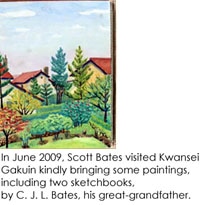
Global Village, Harada-no-mori
When Admiral Matthew Calbraith Perry of the East India Squadron sailed to Japan in 1853, a kyoka, or comic parody, was written: “Awoken from the sleep of a peaceful quiet world by jokisen tea, drinking only four cups, one cannot sleep even at night.” This turns on three puns. Jokisen is the name of a high-quality brand of Japanese tea, but it also means steamship. The word hai means cup and is also used to count ships. And the word taihei means peaceful quiet world, but also means Pacific Ocean. Thus the poet says that only four steamships upset the Tokugawa regime.
More than sixty years later, on December 4, 1917, Captain W. H. Hardy visited Kwansei Gakuin Harada-no-mori campus, our old site. He had been on the crew of the Sasquehana, one of Perry’s four ships, and at eighty-one years old, was said to be the last survivor of the Perry Expedition. On the following day, he gave a lecture just south of the College Building to as many as 1,300 people.
After the conclusion of the Treaty of Amity and Commerce between Japan and the United States in 1858, the Edo shoguate of Japan had sent a delegation led by senior envoy Masaoki Shinmi to the United States. Kikuryo Minakawa, who had been a member of the vice-envoy Norimasa Muragaki’s entourage at that time, went to Harada-no-mori in 1917 to listen to Captain Hardy speak. When Hardy’s lecture was finished, he and Minakawa shook hands with deep emotion. Everybody present witnessed this touching scene.
Captain Hardy received an enthusiastic welcome everywhere he went in Japan over several months. After returning to the United States, he sent a letter to the New York Times, noting, “During all my travels through Japan I never heard one word of criticism about the United States.”
Why was Kwansei Gakuin given such a great opportunity? Partly because the American and Canadian Methodist churches were in charge of its management, and partly because of its location. Harada-no-mori was close to the Port of Kobe. In later years, Prof. Kanzo Hata, a graduate of the Middle School, pointed out this advantage: “The people studying there were awake to the sense of internationalization. We would look down on the port from the school building and pay attention to each trade ship from abroad. We even memorized the names. On holidays we would row a boat over to visit a foreign ship. When tall ships with timbers still came to Kobe from the United States often, we visited one ship on the day before Christmas. We were warmly welcomed by the Captain’s wife and treated to wonderful dinner. Through these experiences KG students became interested in foreign countries. Accordingly, many thought constantly of life abroad from a young age.”
Yuko Ikeda, Kwansei Gakuin Archives (February 2013)
[Special thanks to Camilla Blakeley for editorial assistance.]
【 Click to enlarge. 】
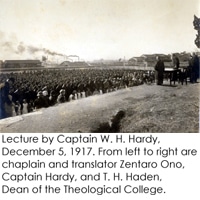
Missions Accomplished
In May 1920, Ian Ozolin (Janis Ozolins), an English teacher at Kwansei Gakuin College, began working as a diplomatic and consular agent of the Republic of Latvia to Japan at the request of J. Mazpolis, who represented Latvia in Siberia and the Urals. Eighteen months had passed since Ozolin’s homeland proclaimed its independence. Each national consulate in Japan dealt with whether to issue visas to the people of this rising nation in its own way. Russia refused to issue visas to Latvians for travel to Vladivostok. The United States had not yet recognized the independence of Latvia and also firmly refused to issue visas. The United Kingdom and France required the applicants to contact London or Paris, respectively, in advance. Italy issued visas without demur. Ozolin reported these situations to Latvia but there is no record of how many passports and visas were issued through his arrangements.
Ozolin was also busy with his teaching duties. He asked Tamotsu Sone, one of his students, to translate his book from English to Japanese. As the work progressed, the two shared a house for almost a year in Maiko, Kobe. According to Sone, Ozolin was a linguistic genius and could speak sixteen languages. The professor bought his student a train pass from Maiko to Nada and taught him German on the train. In class, he taught the poetry of Robert Browning. Later Sone became a scholar of English literature and a recognized authority on Browning.
In July 1921, Ozolin left Japan for Latvia after publishing Kohaku no Kuni (Amber Land, or Latvia, Past and Present). Kwansei Gakuin deeply regretted his resignation. Dean H. F. Woodsworth of the Literary College and President C. J. L. Bates put forward a resolution proposing that Ozolin be given a token of appreciation. It was adopted and 100 yen was provided, a significant sum at that time. The Kwansei Gakuin community thanked Ozolin for his good influence on the students and his prominence in academic knowledge. Everyone sent him off with a prayer for the successful development of Latvia.
Ninety years have now passed. On October 20, 2011, Mr. P?teris Vaivars, the first Latvian ambassador to Japan, visited Kwansei Gakuin to present several saplings of oak, the national tree of Latvia, to President Takutoshi Inoue in commemoration of Ozolin. “Ozolin” means “oak” in Latvian.
Yuko Ikeda, Kwansei Gakuin Archives (October 2012)
[Special thanks to Camilla Blakeley for editorial assistance.]
【 Click to enlarge. 】
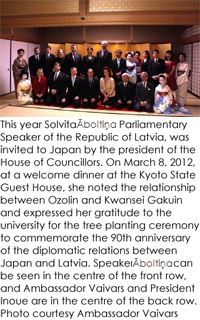
Graduation and the Pacific War
In March 1945, Kwansei Gakuin Middle School held an unusual graduation ceremony for its fourth and the fifth grade students. In Japan, the academic year begins in April and ends in March, but during the war all middle schools had to shorten the enrollment period. The fifth grade graduating in 1945 entered the school in 1940 and completed the five years of enrollment, although wartime mobilization forced them to work in factories and they began full-time labor on June 12th, 1944. The fourth grade graduates entered in 1941 and studied for just three years before being sent to factories for almost a year; they then lost their final year entirely. These two groups graduated together.
From 1941 onward, the school boy uniform all over Japan was a jacket with a turned-down collar, a field cap, and puttees, all in khaki. New students entering the Middle School therefore never had an opportunity to wear the much-coveted KG school uniform of a black jacket, uniquely styled round black cap with the gold crescent school symbol, and white puttees. The senior students had this uniform, and also benefited from the tremendous contribution that North American missionaries had made at the school since its foundation. But all the missionaries had already left Japan before the 1941 group began their studies, and these students missed more than simply a uniform.
The graduation ceremony was held on March 27th, 1945. Two weeks before, Osaka had been attacked heavily from the air, suffering 500,000 casualties. Then, on March 17th before dawn, Kobe was attacked from a low altitude and the diplomas that had nearly been completed for the ceremony were incinerated. At the ceremony, therefore, small makeshift diplomas done in brush writing were handed out. Later, these were exchanged for the larger, official diplomas.
Conditions by these points were extreme. It was just five months before the defeat. B29 bombers came to bomb almost every day and night. By the time the war ended, on August 15th, everyone was desperate just to get by. How many graduates were able to go back to the school for their official diplomas? Interviewing some of them all these years later, one hears, “I have no memory about our graduation ceremony,” or “I did not receive any invitation to the ceremony.”
In April 1945, graduates who had not entered advanced schools were still under control of Kwansei Gakuin Middle School. They were organized within the Practical Department and continued to work in factories. On August 15th, the Imperial Rescript on Surrender was delivered, and demobilization began on the 21st. It appears that Practical Department was then dissolved but the record is unclear.
Yuko Ikeda, Kwansei Gakuin Archives (August 2012)
[Special thanks to Camilla Blakeley for editorial assistance.]
【 Click to enlarge. 】
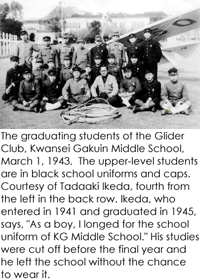
The Genesis of the Kwansei Gakuin Students' Union
The Kwansei Gakuin Students’ Union started on June 29, 1912, with four departments (religion, culture, athletics, and music), three months after the College Department was established. Dean C. J. L. Bates decided to make it truly a student society, with student officers to administrate it and thus have the opportunity to practise self-government. He was told that this could not be done successfully, that it was not the Japanese way, and that other similar attempts had failed. Bates believed, however, that one of the best ways to encourage a sense of responsibility is to trust people and give them responsibilities to bear.
Some of the distinguished activities of the Students’ Union during the Harada-no-mori era (from its inception until March 1929) are described in the History of Kwansei Gakuin Students’ Union, published in 1937. Union members lobbied and fundraised for the construction of the Students’ Association Hall, distributed canned food to victims of the River Yodogawa flood in 1917, established the Students’ Union Fund, sent volunteers to work under the supervision of the Tokyo Prefectural Office with the rescue response following the Great Kanto Earthquake in 1923, established an academic exchange between Kwansei Gakuin and Mt. Koya University, organized cultural lecture tours and a mock Imperial Diet, supported the opposition movement against the U.S. Immigration Act of 1924, and so on. Professor Kanendo (Kenjin) Matsuzawa, a graduate of Tokyo Imperial University and later a member of the Diet, was surprised to see Kwansei Gakuin students going to Tokyo to assist with rescue operations just after the Great Kanto Earthquake, asserting that students of national schools cannot do such things.
“The election campaign, speech, posters, and handbills of the Students’ Union were almost professional. It was just like a small parliamentary election. Students visited each qualified voter, perhaps swaying some with a cup of coffee. These experiences made the students remarkable working members of society from their very first day of graduation,” remarked Matsuzawa. It is notable that the Kwansei Gakuin Students’ Union was completely self-governing and that no other school possessed such a successful union.
Yuko Ikeda, Kwansei Gakuin Archives (June 2012)
[Special thanks to Camilla Blakeley for editorial assistance.]
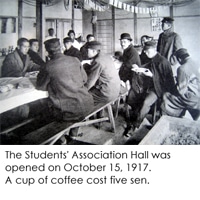
The Origin of “Mastery for Service”
It is widely known that the motto of Kwansei Gakuin is “Mastery for Service.” When I visited the McGill University Archives in Montreal in the autumn of 1999, however, I was surprised to learn that the Macdonald College had the very same motto. Macdonald College was founded by Sir William Macdonald in 1906 as a residential college at McGill for students of Agriculture, Household Service, and Teaching. He was deeply involved in every facet of its development and proposed the motto when the college was established.
At Kwansei Gakuin, “Mastery for Service” was proposed sometime in the 1912-1913 academic year by C. J. L. Bates, who had studied at McGill University for three years. At first, the motto was used only for the College Department, Literary and Commercial, which had just been established in April 1912 with Bates as its first dean.
Is this just a coincidence? Or did Bates consciously borrow the words from Macdonald College?
A letter from Thomas D. Jones to Mr. Adair sheds some light on the case. The undated letter was published in the 1934 Macdonald College Annual, and Armand de Mestral, Bates’s grandson, kindly gave us the information. According to Jones, he was the one who coined the term “Mastery for Service,” and Sir William learned of it through Principal James Wilson Robertson. Jones delivered a series of sermons, entitled “Service,” “Equipment for Service,” and “Efficiency for Service,” at a Methodist Church near the college. Principal Robertson were deeply impressed with these themes and asked Jones’s permission to use one for the college motto. Sir William and Robertson had been involved in the selection of a motto but had not yet found any reference in the classics that embodied their objective precisely. When Jones agreed, Robertson asked him for other themes, and Jones then explained the meaning of “Mastery for Service.” This conversation probably took place in 1907 or 1908 though Jones did not specify in his letter.
David Woodsworth, son of H. F. Woodsworth, who taught at Kwansei Gakuin from 1913 to 1939, told us that Bates had borrowed “Mastery for Service” from Macdonald College. If that is so, then by studying the relationship between Bates, Macdonald, Jones, and Robertson, or perhaps by retracing Bates’s activities during his furlough in Canada from 1909 to 1910, we can learn a little more about how “Mastery for Service” came to be the motto for Kwansei Gakuin.
Yuko Ikeda, Kwansei Gakuin Archives (April 2012)
[Special thanks to Camilla Blakeley for editorial assistance.]
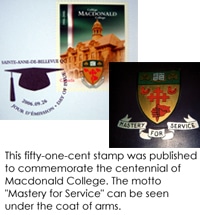
The Origin of “Mastery for Service”
From the time it was founded in 1889, the Academic School of Kwansei Gakuin kept improving its faculty, curriculum, and facilities. These constant efforts were rewarded in 1915 when the school finally received official recognition as a middle school. It could then offer five years of education beyond the primary six years and qualify its graduates to enter government schools of higher learning while exempting them from military conscription during their years in attendance. At this point, it changed its name to the Middle School.
Ryutaro Nagai, a royal alumnus of Kwansei Gakuin, helped greatly with the process. When Kwansei Gakuin made its application to the government, the Minister of Education delayed the decision for so long that school administrators feared it would not be granted. One day C. J. L. Bates, at the time dean of the College Department, received a telegram from Nagai asking him to come to Tokyo.
Shigenobu Okuma, the Prime Minister, was waiting for the two men in his palatial home near Waseda University, which he had founded. After graduating from Kwansei Gakuin, Nagai had attended Waseda University, where he enjoyed Okuma’s favor, so they knew one another well.
Okuma was a great talker. It was not necessary for anyone else to say anything, but when he finally stopped for breath, Nagai told him that Bates had a request. Okuma asked Bates what he could do for him and Bates asked for an introduction to the Minister of Education. Okuma consented and told his son to write it. When it was ready, he put his seal on it. Later in the day, Bates went to the Department of Education and gave the letter to the Minister. In a few days, the application was granted.
It was very unusual for Okuma to make such an introduction. Bates noted, “I was told that Prince Okuma never wrote his name on paper or anything permanent. As he sat by [a] charcoal brazier, he would write in the ashes with the tongs, then quickly cross out the writing so it could not be copied. It was said of him that he talked like a democrat but lived [as] an aristocrat. There is no doubt that by founding Waseda University he did a great deal for liberal education in Japan in those early days of the modern era.”
Yuko Ikeda, Kwansei Gakuin Archives (February 2012)
[Special thanks to Camilla Blakeley for editorial assistance.]
